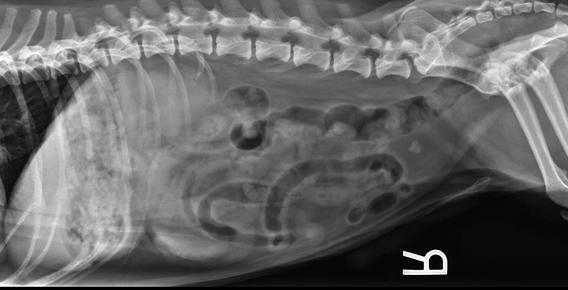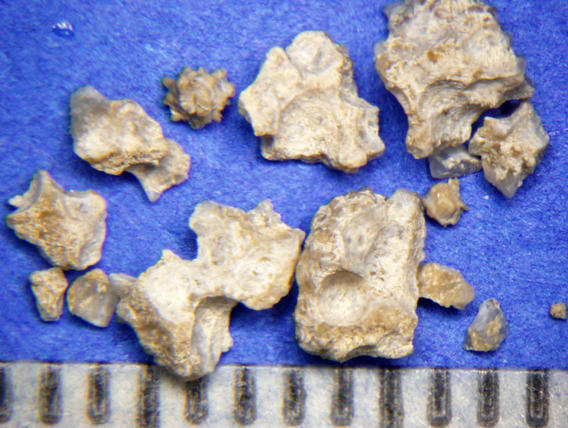Image of the month
Duking out the treatment of struvite/urate urolithiasis
"Duke" is a 12-yr-old MN Shih Tzu presented for intermitted bloody urine. Antibiotics initially resolved clinical signs, but hematuria recurred. Radiographs identified a moderately radiopaque bladder stone (Figure 1). "Duke" was anesthetized, the stone was fragmented by laser lithotripsy (video 1), and the fragments were removed by basket retrieval and voiding urohydropropulsion. Quantitative analysis of the stone was 70% struvite and 30% urate (Figure 2). Taking a second look at the radiograph, liver size was normal but small. Serum concentrations of liver enzymes were unremarkable: ALP = 28 U/L (normal = 22-92), AST U/L = 22 (normal = 16-44) and ALP U/L = 25 (normal = 8 to 139).
How would you manage this dog?

Diagnostically
- Shih Tzu's are predisposed to porto-vascular shunts. Consider evaluating bile acids in breeds at risk for liver shunts. Postprandial serum bile acid concentration was high (52 µmol/L; normal is 15 to 25).
- Culture urine, struvite uroliths in dogs are usually due to a urinary tract infection.

Therapeutically
- To prevent urate, consider canned lower purine/protein foods usually formulated with egg, dairy, or vegetable proteins that result in a more neutral or alkaline urine pH (e.g. Hill's l/d, u/d, i/d Sensitive Canine, HA Hydrolyzed, others).
- To prevent struvite, control urinary tract infection with periodic urine cultures and appropriate antimicrobics, when needed.
If bile acids were normal, we would still avoid urine acidification (a common feature of struvitolytic diets) because urate is more soluble in alkaline urine and therefore less likely to precipitate out.
Additional resources
- Read more in depth recommendations to prevent canine struvite/urate uroliths (PDF)
- Watch videos of voiding urohydropropulsion
- Use of urohydropropulsion, cystoscopy and lithotripsy to manage feline urolithiasis, Jody Lulich DVM, PhD, DACVIM, Hill's Global Symposium on Feline Lower Urinary Tract Health, Prague, 23rd - 24th April 2014 Voiding urohydropropulsion. Lessons from 5 years of experience. Lulich, JP, et al, Vet Clin North Am Small Anim Pract. 1999 Jan;29(1):283-91, xiv.